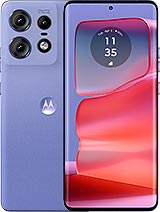Motorola Edge 50 Fusion vs. Edge 50 Pro
If you are eyeing a new Motorola phone, you may have stumbled upon the Motorola Edge 50 Fusion and the Motorola Edge 50 Pro, which honestly look visually quite identical. There is a bunch of differences under their respective hood, though, and we’ll have a look at those in this comparison to assess whether the huge difference in price is well deserved. The Edge 50 Fusion retails for around €350, while the Pro can be found for almost double that at around €580.
Sure, the Pro is expected to be the better device in every way, but maybe the Edge 50 Fusion has what it takes to get you a lot of the same way at a discount? Let’s look into it.
Table of Contents:
For starters, you can compare the complete specs sheets or directly continue with our editor’s assessment in the following text.
Size comparison
The two phones are practically identical in size. The Fusion is just slightly bigger but also thinner. Both phones have identically sized 6.7-inch curved displays, so it only makes sense that they would have similar form factors.
The difference in thickness is a bit perplexing, considering that the Pro, which is the thicker of the two, has a smaller 4,500 mAh battery (compared to 5,000 mAh in the Fusion). Apparently, the extra space is otherwise utilized on the Pro with things like cameras and wireless charging hardware.
Despite its smaller battery, the Edge 50 Pro is also a bit heavier than the Fusion – 186 grams, compared to 174.9 grams. Some of this might be because the Pro has an aluminum frame, whereas the Fusion has a plastic one. The rest of the bill of materials is quite similar across both phones. They get Gorilla Glass on the front. It is important to note that both phones support IP68 ingress protection.
Let’s talk about color options for a bit. The Edge 50 Fusion can be had in Forest Blue, Marshmallow Blue or Hot Pink. All three variants come with different finishes on the back. The Marshmallow Blue is vegan leather, the Hot Pink is vegan suede and the Forest Blue has a smooth matte finish.
The Edge 50 Pro has even more color options, including Luxe Lavender, Black Beauty, Moonlight Pearl and Vanilla Cream. In the Luxe Lavender colorway and the Black Beauty variant (both Pantone colors), the back panel is made of leather-like plastic or silicone vegan leather. Moonlight Pearl has an off-white acetate panel with a matte treatment.
So, with both phones, you get a choice of interesting colors and finishes.
The Edge 50 Fusion and Edge 50 Pro have very similar overall design language. In fact, their almost identical aggressively-curved displays with a punch-hole selfie are almost impossible to tell apart from the front.
The backs are a bit more distinctive but that’s only because the Pro has an extra camera and a bigger camera island.
Both phones have stereo speakers and NFC. Neither device has expandable storage nor an IR blaster, 3.5mm jack or FM radio receiver.
If you are interested in Motorola’s excellent ReadyFor connectivity and desktop experience (now called Smart Connect), you should know that the Fusion does have full support for all of the features, but it lacks wired video output via its Type-C port so the connection has to be wireless only. The Type-C on the Fusion is only backed up by a USB 2.0 data connection. The Pro, on the other hand, gets a USB 3.1 data link and DisplayPort 1.4 video output support.
Display comparison
The Edge 50 Fusion and Edge 50 Pro displays are identical in size at 6.70 inches. The Pro does have a slightly higher resolution of 1220 x 2712 pixels, compared to 1080 x 2400 on the Fusion, which also results in a bit higher pixel density on the Pro – 446 ppi, compared to 393 ppi. The actual difference in sharpness is hardly noticeable in real life, though.
So, even though they match up in size, bezels and curvature, the OLED panels on the two phones aren’t identical. A fact further demonstrated by the small detail that the Fusion actually comes with a 120Hz refresh rate in Latin America and only gets the full 144Hz in international markets. All the while, the Edge 50 Pro gets 144Hz in every market.
In terms of actual performance, like brightness, the two phones are practically identical, putting out max brightness numbers of around 1,300 nits, which is perfectly comfortable outdoors.
Battery life
The Moto Edge 50 Fusion has the bigger battery pack of the two at 5,000 mAh, compared to 4,500 mAh in the Edge 50 Pro. It’s not a huge difference in capacity, but one that is still noticeable and has a reflection on the Active Use Score.
Both phones manage solid battery life but nothing spectacular. You do get better video streaming runtimes with the Edge 50 Fusion but otherwise both phones have the same overall endurance in our testing.
Charging speed
The Fusion might have squeezed out a small win in the battery endurance department, but there is no doubt that the Edge 50 Pro is the clear winner when it comes to charging.
Not only does its 125W wired charging fill up almost the entire battery in fifteen minutes, but the Edge 50 Pro is also a lot more versatile in the charging department, offering 50W wireless and 10W reverse wireless charging. Both of which are missing from the Fusion.
Speaker test
The Edge 50 Fusion and Edge 50 Pro have stereo speaker setups. Both of these setups are very good and quite similar in their overall performance. Both phones managed a VERY GOOD score in our standardized loudness test with clean mids, good low-end presence and balanced high-range response.
Performance
Despite its higher price tag, the Edge 50 Pro isn’t technically running a flagship chipset. Instead, it gets a still quite potent Snapdragon 7 Gen 3. It offers almost all the bells and whistles one could want regarding additional features and connectivity.
The Pro’s memory options include 128GB 8GB RAM, 256GB 8GB RAM, 256GB 12GB RAM and 512GB 12GB RAM, though not all variants are available on all markets. Storage chips are said to be UFS 2.2, though our testing got read and write scores more akin to UFS 3.1.
The Edge 50 Fusion is rocking one of two chipsets – the Snapdragon 7s Gen 2 on international units and the Snapdragon 6 Gen 1 in Latin America. We tested the former on our review unit, and as Qualcomm’s nomenclature goes, the “s” denotes a lower-end product.
Naturally, you can expect less performance than on the Edge 50 Pro, though not necessarily enough to be noticeable in real-world use. Storage options again are plentiful but not universally available on all markets: 128GB 8GB RAM, 256GB 8GB RAM, 256GB 12GB RAM and 512GB 12GB RAM. Storage chips are once again UFS 2.2.
Neither phone has expandable storage.
Benchmark performance
As expected, the Edge 50 Fusion gets outperformed by the Edge 50 Pro in every department.
However, as we mentioned, the Edge 50 Fusion is not strapped for power. It has enough oomph to go through pretty much any task you throw at it.
Camera comparison
The cameras on both phones look vaguely similar at first glance. At least the main cameras do, since the Edge 50 Pro clearly has the leg up with its secondary dedicated optical zoom cam. And that’s not the only hardware advantage it has.
Let’s start with the Edge 50 Fusion first. Its main 50MP camera uses a Sony LYT-700C sensor. As per Motorola, it is the most advanced sensor in the segment. It measures 1/1.56″ with 1.0µm individual pixels and sits behind an f/1.9 lens. It has dual pixel autofocus and OIS. The ultrawide camera is pretty powerful, mainly since it offers autofocus and can double as a macro shooter. Finally, we have the selfie camera, which is a 32MP unit with fixed focus. It isn’t particularly special, but it still offers plenty of resolution.
Moving on to the Edge 50 Pro, it also has a 50MP main camera. However, this one has multi-directional PDAF, Laser AF and OIS. It doesn’t use a Sony sensor, like the Fusion, but rather an OmniVision OV50E (1/1.55″, 1.0µm – 2.0µm) with an f/1.4 lens, which is impressively bright. The ultrawide camera appears to be identical across the Edge 50 Fusion and Edge 50 Pro. The Edge 50 Pro has a dedicated telephoto. It offers 3x optical zoom with OIS, albeit with a rather modest resolution of 10MP. The Edge 50 Pro also gets the better selfie camera. It is a 50MP snapper with a decently-bright f/1.9 lens and autofocus.
Image quality
The Edge 50 Fusion and Edge 50 Pro capture pretty great 12.5MP binned photos with their main cameras. The photos on the Fusion are a bit more aggressively processed. That means some extra sharpening, more contrast and higher saturation. The Edge 50 Pro is a bit more relaxed with its processing. We would call it slightly more mature. There is less sharpening, and colors aren’t nearly as saturated. The dynamic range on the Pro is notably better, too. Still, the difference in overall quality between the Fusion and the Pro isn’t all that large on the main camera.




Motorola Edge 50 Fusion: main camera samples




Motorola Edge 50 Pro: main camera samples
These observations mostly carry over to 2x zoom shots. Both phones capture these with the main camera, making them essentially digital zooms. Honestly, we kind of prefer the more aggressive sharpening and processing done by the Edge 50 Fusion in this particular case.




Motorola Edge 50 Fusion: main camera 2x zoom samples




Motorola Edge 50 Pro: main camera 2x zoom samples
Things understandably tip in favor of the Edge 50 Pro when it comes to 3x zoom shots. While the Fusion still has to rely on increasingly soft digital crops from the main camera, the Edge 50 Fusion has a dedicated 3x telephoto. It produces very clean and detailed shots with nice and balanced processing.




Motorola Edge 50 Fusion: 3x digital zoom samples




Motorola Edge 50 Pro: 3x optical zoom samples
Since the two phones essentially share the same ultrawide camera, it only makes sense for their ultrawide photos to be very comparable. Indeed, in terms of detail and overall quality, they are. Still, there are some differences in processing. Once again, the Edge 50 Fusion seems the more aggressive of the two, sharpening and saturating colors more. The Pro seems to have a slight advantage in dynamic range, so perhaps it is doing better HDR stacking.




Motorola Edge 50 Fusion: ultrawide camera samples




Motorola Edge 50 Pro: ultrawide camera samples
The selfie camera on the Edge 50 Pro is noticeably better than that on the Edge 50 Fusion. Skin tone and particularly skin texture come through a lot better, and the inclusion of autofocus is a gamechanger.




Motorola Edge 50 Fusion: selfie camera samples




Motorola Edge 50 Pro: selfie camera samples
While both phones hold their own pretty well in low-light conditions, the main camera on the Edge 50 Pro understandably has a slight edge over its sibling. An automatic night mode on both devices triggers consistently and accurately.




Motorola Edge 50 Fusion: low-light camera samples




Motorola Edge 50 Pro: low-light camera samples
Video quality
Despite having some notable differences in aspects like cameras and performance, the Edge 50 Fusion and the Edge 50 Pro can capture 4K@30fps video across all their respective cameras. That includes both selfies, both ultrawides (essentially the same) and the telephoto on the Pro.
Interestingly enough, looking at footage from the main cameras on both phones, we would say that the Edge 50 Fusion has a slight edge in detail and overall quality over the Edge 50 Pro. A bit surprising, but a fact. That observation carries over to 2x videos as well. Those from the Edge 50 Pro are just a bit softer and muddier. 3x videos are a whole different story, though, and here, the Edge 50 Pro clearly takes the lead with its dedicated telephoto camera. It just captures a lot cleaner 4K video with more detail compared to the digital zoom from the main camera of the Edge 50 Fusion.
Regarding video capture, the selfie cameras on the Edge 50 Pro and Edge 50 Fusion are a lot closer in quality than with photos. However, the Pro manages better low-light video quality on its main camera with less noise, better and more defined detail, and more competent light source handling.






Motorola Edge 50 Fusion: video quality samples






Motorola Edge 50 Pro: video quality samples
Verdict
There is no doubt which is the better overall device out of the two. The Edge 50 Pro is simply, through and through, the better phone. The Edge 50 Fusion only managed a small victory in the battery endurance department, but nothing significant enough to be a major deciding factor. Plus, the Edge 50 Pro arguably makes up for it with its faster and more versatile charging setup.
That being said, the Edge 50 Fusion is not a bad phone by any means. On the contrary, it is a very well-rounded offering from Motorola. It looks and feels great, has ample performance and a great set of features on top of an otherwise clean OS, its battery and speakers are solid, and the same can generally be said about the cameras as well.
Arguably, for most, especially less demanding or casual users, the Edge 50 Fusion is the better deal. The value proposition is just much, much better. But, if you find yourself wanting some extra camera prowess, performance or even something niche like the DisplayPort video output over the Type-C port, then the Edge 50 Pro is the way to go.
- The significantly lower price tag.
- Same premium design with IP68 certification.
- The matching OLED in everything but resolution and HDR support.
- Equally good speakers.
- The longer video streaming runtime.
- The better daylight video recording quality.
Get the Motorola Edge 50 Fusion for:
- The aluminum frame instead of plastic.
- The significantly faster charging.
- The wireless charging support.
- The ~50% better performing chipset.
- The higher-res screen with HDR10 support.
- The 3x optical zoom camera and better overall photos.
- USB 3.1 port with support for DisplayPort 1.4 over Type-C.
Get the Motorola Edge 50 Pro for:







